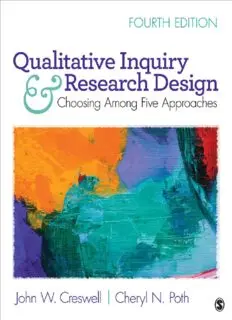
Qualitative Inquiry & Research Design: Choosing Among Five Approaches PDF
Preview Qualitative Inquiry & Research Design: Choosing Among Five Approaches
Qualitative Inquiry & Research Design Fourth Edition John dedicates this book to Uncle Jim (James W. Marshall, MD, 1915–1997), who provided love, support, and inspiration. Cheryl dedicates this book to her dad (Richard F. Poth, MBA, 1944–2016), who instilled confidence for trying new things, lessons for guiding life choices, and encouragement for pursuing bold dreams. Qualitative Inquiry & Research Design Choosing Among Five Approaches Fourth Edition John W. Creswell University of Michigan Cheryl N. Poth University of Alberta Brief Contents 1. About the Authors 2. Acknowledgments 3. Analytic Table of Contents by Approach 4. List of Tables and Figures 5. 1 • Introduction 6. 2 • Philosophical Assumptions and Interpretive Frameworks 7. 3 • Designing a Qualitative Study 8. 4 • Five Qualitative Approaches to Inquiry 9. 5 • Five Different Qualitative Studies 10. 6 • Introducing and Focusing the Study 11. 7 • Data Collection 12. 8 • Data Analysis and Representation 13. 9 • Writing a Qualitative Study 14. 10 • Standards of Validation and Evaluation 15. 11 • “Turning the Story” and Conclusion 16. Appendix A. An Annotated Glossary of Terms 17. Appendix B. A Narrative Research Study—“Living in the Space Between Participant and Researcher as a Narrative Inquirer: Examining Ethnic Identity of Chinese Canadian Students as Conflicting Stories to Live By” 18. Appendix C. A Phenomenological Study—“Cognitive Representations of AIDS” 19. Appendix D. A Grounded Theory Study—“Developing Long-Term Physical Activity Participation: A Grounded Theory Study With African American Women” 20. Appendix E. An Ethnography—“British-Born Pakistani and Bangladeshi Young Men: Exploring Unstable Concepts of Muslim Islamophobia and Racialization” 21. Appendix F. A Case Study—“Relational Underpinnings and Professionality —A Case Study of a Teacher’s Practices Involving Students With Experiences of School Failure” 22. References 23. Name Index 24. Subject Index Detailed Contents About the Authors Acknowledgments Analytic Table of Contents by Approach List of Tables and Figures 1. Introduction Purpose and Rationale for the Book What Is New in This Edition Positioning Ourselves Definition of Qualitative Research Selection of the Five Approaches Key Book Readings Narrative Research Phenomenology Grounded Theory Ethnography Case Study Audience Organization 2. Philosophical Assumptions and Interpretive Frameworks Questions for Discussion Situating Philosophy and Interpretive Frameworks Within the Research Process Philosophical Assumptions Why Philosophy Is Important Four Philosophical Assumptions Writing Philosophical Assumptions Into Qualitative Studies Interpretive Frameworks Postpositivism Social Constructivism Transformative Frameworks Postmodern Perspectives Pragmatism Feminist Theories Critical Theory and Critical Race Theory Queer Theory Disability Theories The Practice of Using Interpretive Frameworks in Qualitative Research Linking Philosophy and Interpretive Frameworks in Qualitative Research Chapter Check-In Summary Further Readings 3. Designing a Qualitative Study Questions for Discussion The Characteristics of Qualitative Research When to Use Qualitative Research What a Qualitative Study Requires From Us The Features of a “Good” Qualitative Study The Process of Designing a Qualitative Study Preliminary Considerations Phases in the Research Process Elements in All Phases of the Research Ethics in Qualitative Research The Design Structures of a Plan or Proposal Design Considerations Useful for Engaging Readers General Writing Structures Chapter Check-In Summary Further Readings 4. Five Qualitative Approaches to Inquiry Questions for Discussion Deciding Among the Five Approaches Narrative Research Definition of Narrative Research Origin of Narrative Research Defining Features of Narrative Studies Types of Narratives Procedures for Conducting Narrative Research Challenges in Narrative Research Phenomenological Research Definition of Phenomenological Research Origins of Phenomenological Research Defining Features of Phenomenology Types of Phenomenology Procedures for Conducting Phenomenological Research Challenges in Phenomenology Grounded Theory Research Definition of Grounded Theory Research Origins of Grounded Theory Research Defining Features of Grounded Theory Types of Grounded Theory Studies Procedures for Conducting Grounded Theory Research Challenges in Grounded Theory Research Ethnographic Research Definition of Ethnographic Research Origins of Ethnographic Research Defining Features of Ethnographies Types of Ethnographies Procedures for Conducting an Ethnography Challenges in Ethnographic Research Case Study Research Definition of Case Study Research Origins of Case Study Research Defining Features of Case Studies Types of Case Studies Procedures for Conducting a Case Study Challenges in Case Study Research Comparing the Five Approaches Chapter Check-In Summary Further Readings 5. Five Different Qualitative Studies Questions for Discussion A Narrative Study (Chan, 2010; see Appendix B) A Phenomenological Study (Anderson & Spencer, 2002; see Appendix C) A Grounded Theory Study (Harley et al., 2009; see Appendix D) An Ethnographic Study (Mac an Ghaill & Haywood, 2015; see Appendix E) A Case Study (Frelin, 2015; see Appendix F) Differences Among the Approaches Central Features of Each Approach Selecting Your Approach Chapter Check-In Summary Further Readings 6. Introducing and Focusing the Study Questions for Discussion Interrelating the Study Problem, Purpose, and Questions Within Research The Research Problem Statement The Purpose Statement The Research Questions The Central Question Subquestions Chapter Check-In Summary Further Readings 7. Data Collection Questions for Discussion The Data Collection Circle
